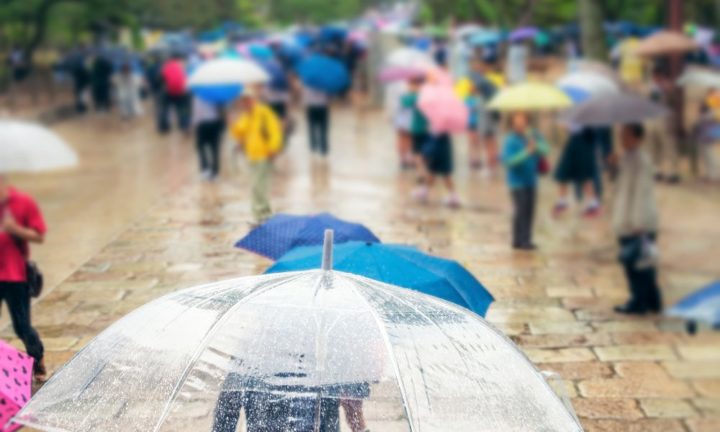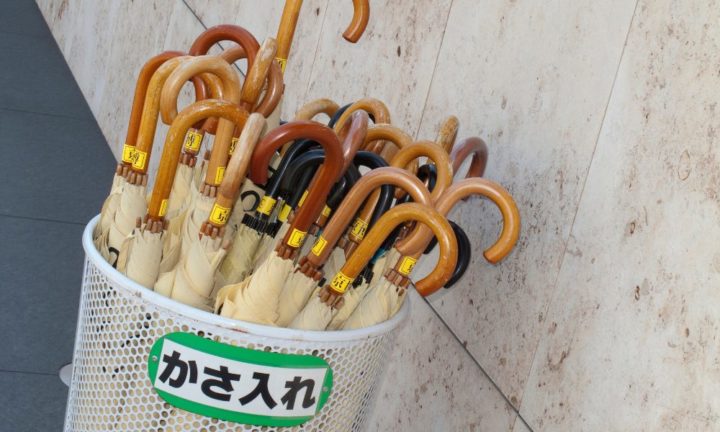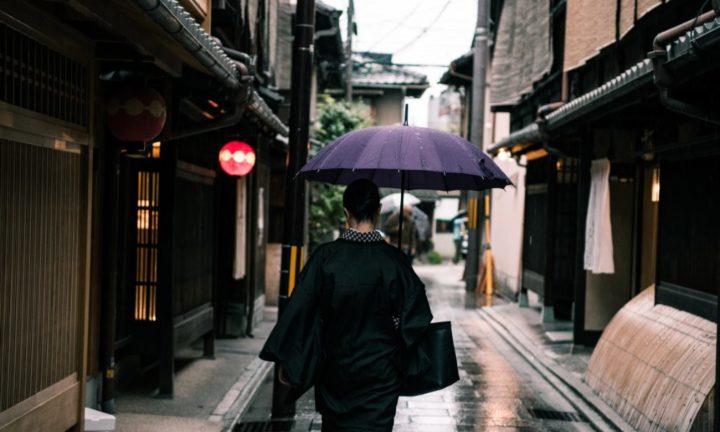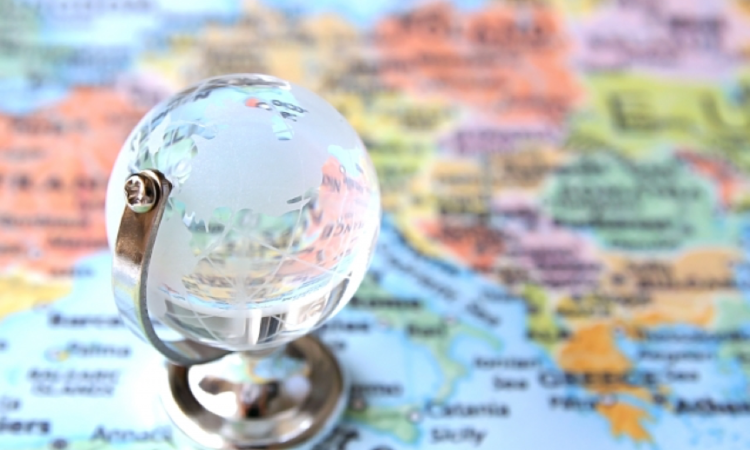If you have walked the streets of Japan during the tsuyu, 梅雨 (rainy season), you will undoubtedly have seen a mismatched horde of clear, plastic kasa (umbrella) that protects people from the torrents from above. Thought you knew everything about umbrellas in Japan? Read on for a surprising kasa-thief prevention method and staggering numbers that might stop you from reaching for a crisp new plastic conbini umbrella during the next downpour.
Consumption of Umbrellas in Japan
The sight of Japan’s plastic, see-through umbrellas has become ubiquitous with rain within the country, and they are synonymous with each other. Almost every Japanese citizen has owned an umbrella of this style at some point in their life, as they’re cheap and easy to procure at a convenience store or supermarket. Whether plastic or not, purchase of umbrellas is high in Japan! According to a survey conducted in May 2022 by Weathernews.jp, people in Japan own an average of 4.2 umbrellas each, increasing to 4.9 in Tokyo.
It’s said the number of umbrellas owned per capita and the number of plastic umbrellas consumed per capita by the Japanese people are both said to be the highest in the world. Japan Umbrella Promotion Association states that around 120-130 million umbrellas are sold in Japan every year; of these, 60%, or about 80 million, are plastic umbrellas. As they are difficult to recycle, they are disposed of in landfills or incinerated.
What Can We Do About the High Consumption Rate of Umbrellas in Japan?
Recycling of Plastic Umbrellas by PLASTICITY
PLASTICITY is a company dedicated to finding innovative uses for this hard-to-recycle material. With a vision to cease operations within the next decade, as they hope plastic umbrella materials will be phased out, PLASTICITY has developed a method to crimp the material into multiple layers. This technique preserves the umbrella material’s water and stain-resistance properties while transforming it into bags and other practical products.
The company purchases plastic umbrella materials no longer needed at home, starting with one umbrella, and exchanges it for 100 yen worth of points that can used on their online store, or donates it to certified NPO, “greenbird”. To reduce waste, why not donate your umbrella to be recycled before throwing it away?
Rental Umbrellas Available Nationwide
Ever wanted quick access to an umbrella without purchasing a cheap plastic umbrella that’s sure to break in the next strong gust of wind? Now, you can rent umbrellas at certain useful locations throughout Japan and help reduce plastic umbrella waste.
Ikasa is an umbrella-sharing service launched in Tokyo in 2018. The service hopes to reduce plastic umbrella waste in Japan and reduce the consumption of single-use umbrellas to zero by 2030. Ikasa aims to provide a sustainable system where umbrella-sharing can thrive and change the current mindset of “umbrellas being disposable” to “umbrella sharing as the norm”. Using the Ikasa app, you can borrow an umbrella at certain spots in train stations, offices, and other locations by scanning the QR code.
The app currently has more than 300,000 registered users and is available in the Tokyo metropolitan area, Kansai, Aichi, Okayama, Fukuoka, Saga, and other regions. It has approximately 950 spots, most of which are along railway lines.
Not only are Ikasa umbrellas more ecologically friendly, but at ¥140 for 24 hours, they are cheaper and more durable than plastic umbrellas and more convenient than folding umbrellas. Why not try it, and let’s make umbrella-sharing the norm?
Why Are So Many Umbrellas Consumed in Japan?

Image credits: Canva.com
Tsuyu: The Plum Fall
In 2022, Japan received an average annual rainfall of approximately 1.54 meters. However, despite having some incredible precipitation-heavy areas and seasons, there is a lot of variation in the climate and areas of Japan. Some areas receive incredibly dense precipitation, such as the coastal prefectures on the eastern seaboard, while some of the prefectures in Hokkaido, like Okhotsk, receive as little as 750 mm per year.
Japan overall sees the most rainfall during the summer months, a period of time called tsuyu (梅雨) that lasts from early June to mid-July for most of the country, with there being slight regional variations such as it arriving a month earlier in Okinawa to the south, and Hokkaido not feeling the effects of tsuyu at all.
Tsuyu is a Chinese term that translates to “plum rain”, as it was during this season of the year that the plums would turn yellow and fall at the south banks of the Yangtze, and it was also a historical belief that the plums would then evaporate and the plant turns into rain which would be the cause of the rainy season.
The rainy season in East Asia is caused by an east-west zone of disturbed weather during spring. This front stretches from the east coast of China towards Taiwan and Okinawa, then shifts north and eastward into the southern peninsula of South Korea and Japan.
The weather front forms when the moist air over the Pacific meets the cooler continental air masses. The front and the formation of frontal depressions along it bring precipitation to most of East Asia. As the front moves back and forth depending on the strength of cool and warm air masses, there is often prolonged precipitation and sometimes flooding in countries such as Japan and China.
Japan receives the highest amount of rainfall during June, with nearly 200 mm of average monthly precipitation. The next highest month of rainfall is September and October, which is another rainy season called the Sazanka Tsuyu, meaning the “rainy season of the Camellia” on account of the timing of the blossoming of the seasonal flower of the same name.
With global climate change not seeming to be stopping anytime soon, more bouts of what have been called “Guerrilla rain” seem to be on the horizon for Japan. These are short and intense events of rainfall across the country that can stop as quickly as they appear – often causing people to purchase the first umbrellas that come to hand (usually a cheap plastic umbrella from the conbini).
Umbrella Crime in Japan

Image credits: Canva.com
Japan has gained a reputation for being one of the safest countries on the planet. Its cities are some of the safest in the world, especially compared to cities of comparable size in other countries. It is common to have your dropped items returned to you, and lost items eventually make their way back to their owner.
It can come as a surprise to many, even those who live in the country, that there is a massive crime epidemic in Japan – a crime epidemic involving umbrellas! The plastic, see-through umbrellas are Japan’s most stolen item.
You might have experienced it firsthand. Maybe you left your umbrella in the stand outside 7-Eleven, only to return not even two minutes later and be the victim of the most heinous of crimes—umbrella theft.
With the greatest number of umbrellas per head in the world, you would think that the people of Japan would not have to resort to stealing umbrellas to make do. However, it seems that as more umbrellas are introduced into the system, the rates of umbrella thievery actually increase, possibly due to the increasing instances of guerrilla rain in Japan.
Many people would just brush aside umbrella thievery cases as accidents or mere mistakes, especially since nearly all umbrellas look identical when stored in containers outside shops and buildings. However, the complete commonality of the occurrence and the rates at which it occurs make me believe that nearly all of these thefts are voluntary and pre-meditated.
Mi Kasa Es Tu Kasa
Some believers within the umbrella community of Japan believe that umbrellas should be communal and that an idle umbrella is for the free use of anyone. They believe umbrellas are loans that you return to the next stand at the next possible moment to be returned to the global network of communal umbrellas of Japan.
However, if only a few people follow this code of honour, then someone will end up with a stolen umbrella and no replacement—a predicament no one wants to be in when it is raining heavily.
There is also the issue of people using this ‘system’ to ‘upgrade’ their umbrellas and slowly gain better and more expensive umbrellas without feeling guilty about it as they are simply working with the community of umbrella users.
The Surprising Fight Back

Image credits: Canva.com
In response to this wave of crime that has steadily risen in Japan, many of its residents have begun to fight back and work to battle the army of unknown umbrella stealers.
One popular scheme that people have begun implementing is to write the kanji for curses upon the umbrella to try and ward off the would-be robbers. A whole array of different curses and wording imply that stealing this umbrella will place a curse upon the stealer.
Some enterprising artists have even begun drawing creepy and scary-looking faces on the handles to repulse anyone who wants to steal the umbrella.
One clever umbrella owner placed a fake tracking chip on the handle of the umbrella and wrote “umbrella tracker” next to it as an extra way to try to deter thieves.
While many of you may think these plots and plans are trivially useless and would not work as a deterrent to stop thievery, when sitting amongst numerous identical-looking umbrellas in a stand, ensuring your umbrella stands out from the crowd and looks unattractive to any potential thieves is half the battle won. You want your umbrella to stand out and look silly, as the more conspicuous, the more difficult it is for a thief to bring themselves to take it.
History of Umbrellas in Japan
Japan has a long and varied history with kasa. Silk umbrellas were introduced into Japan around 1500 years ago from China. The first Japanese-style folding umbrella was made in the 16th century. In years past, only aristocrats used them until they became a daily item for the populace in the 17th century.
During the Edo Period umbrellas became an important part of Japanese culture and were first used as props for Kabuki (a traditional Japanese dance). Here, umbrellas’ artistic aspects and more practical applications were pursued. Oil paper was used to create the umbrellas and they became foldable, creating the wagasa (Japanese umbrella).
The Western-style umbrella was only brought to Japan from the UK in the early 1880s, but mass production for use by the general populace did not begin until after the Meiji Restoration in the late 19th century.
Currently, most of the signature plastic Japanese umbrellas are mass-produced in neighbouring China and then shipped to Japan for their use.
Umbrellas in Japan Protecting A Nation of Rain
Wherever you are in Japan, you will undoubtedly have experience with umbrellas. Whether they be clear or colourful, plastic or fabric, Western or Asian, for rain or sun, umbrellas are part of the nation’s identity and provide a deep look into the psyche of Japanese culture.
It is important to have an umbrella in Japan, especially during summer, when the rain can turn on and off like a flickering light. An umbrella is essential for those living in Japan, which has almost hourly downpours that can occur anytime.
Just please make sure not to steal anyone else’s umbrella, we are all trying to stay dry after all.
More Reads:
- Tsuyu: 5 Things to Know About Japan’s Rainy Season
- Recycling in Japan: How Much Waste Really Gets Recycled?
Featured image credits: Canva.com






